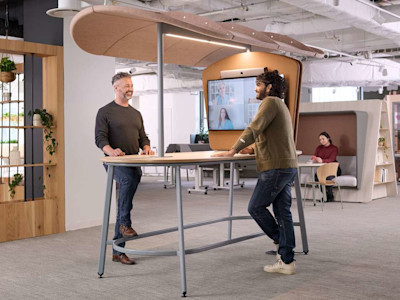Here's Why Flexible Work Design Makes Good Business Sense...

Updated May 2023 A flexible office design is key to facilitating a company's ability to pivot in a new direction. Businesses that change with the economy—not just the market economy, but the economy of employee satisfaction and retention—will prioritize flexibility and come out on top. Flexible workspaces offer several advantages over traditional workplaces. These include the ability to scale and adjust to new working styles like hybrid work. They also provide a balance between collaborative spaces and individual working or quiet zones. Flexible workspaces often utilize modular furniture and other components to ensure their adaptability to changing business needs. This means that no one flexible office layout will be like another. What’s important in a flexible work design is the ability to change and grow as the business does.
Design That Prioritizes Workplace Flexibility Also Prioritizes Affordability

What is workplace flexibility in terms of office design? Simply put, it's the ability to reconfigure your physical office space to meet the needs of your employees, enabling better productivity, functionality, and comfort.
Cubicles are great for everyone to have their own fiefdom and knickknacks, but if your workers leave their desk frequently to meet with their team, consult with clients, or conduct other business, then a rigid workplace design is wasteful and can even hinder employee creativity and productivity. That in turn, can stunt business growth.
Flexible Design Embraces the Motto “Work Where the Wi-Fi Is”
Connectivity breeds mobility, with laptops, tablets, and smartphones bringing unprecedented levels of flexibility to your workforce. As long as they have a network connection and a device on which to work, it doesn't really matter where employees sit. A flexible workplace design recognizes this innately, incorporating flexible office furniture that can be used to promote rather than prevent collaboration.

Flexible Office Design Works for Every Budget
Not every company has a massive headquarters or the budget for top-of-the-line architectural and design firms to renovate their space. In this case, a flexible workspace is ideal. If your workers leave their desk frequently to meet with their team, consult with clients, or conduct other business, then a rigid workplace design is wasteful and can even hinder employee creativity and productivity. That in turn, can stunt business growth.
Flexible Work Design Embraces Work-Life Balance
Post-COVID, organizations are beginning to catch on to what employees have long known: work-life balance is important. Flexible work environments empower employees. They can own the way in which they work, alone or with others. They can adapt their environment to fit their needs. That said, working in an office with flexible furniture can make employees feel more autonomous, not to mention more empowered to work in the way they need to get things done. This can help the business realize growth, but it can also increase productivity in a way that’s better for employees – therefore also helping with employee retention.
Flexible Workspace Design Fosters Creativity in Small Spaces

Explore Our Flexible Office Design Solutions
Wondering how flexible office design can help your business? Strong Project offers a variety of flexible office furniture that is quite literally designed to fit a variety of business and employee needs – yours included. This article was originally published on inc.com Want to explore more? Check out these related topics:



